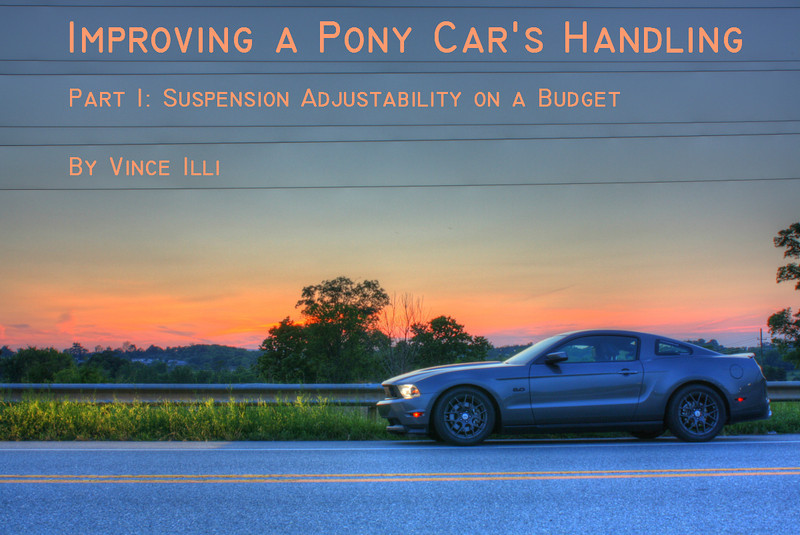,
 |
| Steve applies grease to both ends of the Panhard bar and then installs it. Evolution has found that applying grease to both ends cuts way down on the increase in NVH found with using aftermarket bars. |
 |
Here’s the rear end completed. Note that at the time, my rear Konis were backordered. I installed them the following week in my garage using only jack stands and hand tools. |
After buttoning up the rear end, Steve adjusted the new panhard bar to re-center the rear axle, and then drove the Mustang next door to Evolution’s alignment rack.
 |
Detail of the adjustability of the front suspension. The top of the strut has a notch that accepts that trademark Koni dial, allowing adjustment of rebound through simply twisting it. |
The caster/camber plates from Maximum Motorsports are different than others I’ve used previously. To adjust the suspension, you raise the front of the vehicle and loosen all five bolts on each side. You then set the caster where you want it and tighten the larger bolt at the top. Next you set the camber and tighten the other four bolts. All of the “mechanisms” are hidden in the strut tower, providing a clean installation.
 |
Ever watch a computerized alignment done? It uses lasers. LASERS! |
I had the stock caster increased to the maximum available with the new plates, an improvement of about half a degree over stock. The factory camber is -0.7°, which I had increased to -1.4°. This is technically within factory tolerances and shouldn’t cause too much additional wear on my front tires. I’ll be rotating the tires often just to be sure.
I was immediately aware of the differences on the street. Initial turn-in was improved dramatically. When driving enthusiastically on back roads, I noticed that the tendency to understeer post-apex was almost completely gone. Tightening the rear damping by another half turn eliminated that altogether and made the car feel almost completely neutral.
Of course, the real test was the autocross course. Body roll was drastically reduced, to the point where other people commented on how “flat” the Mustang was through the corners. The car felt much more neutral and no longer “fought” me after the apex. However, I neglected one thing until the very last run of the day: checking my front tire pressures with chalk. Since I have twice as much negative camber, my outside front tire is more “flat” against the pavement, meaning it will roll onto the sidewall less. I used to run 40 psi up front with my stock suspension and ran the same thing with my new equipment. Chalking the tires, however, showed that I could drop at least 2 psi out of the front tires and get even better turn-in response.
 |
This chalk mark shows the front sidewalls are not deforming at all under cornering loads. In other words, I can drop out some air pressure in my tires to increase grip and turn-in. |
In summary, you don’t need to spend a ton of money to make your car handle better and provide a bit of adjustability. Good springs and shocks go a long way—without breaking the bank. My Mustang no longer handles like a Mustang; it is much more composed and actually reminds me of riding in a smaller car in terms of handling. It has become less of a “point-and-shoot” car and more of a precision instrument. I have more parts ready to go on already. Next up is eliminating that wonky panhard bar with a Watts linkage. (Somewhere, Mike Kojima is reading this and angrily shaking his fist at the computer screen. He hates Watts links.)



